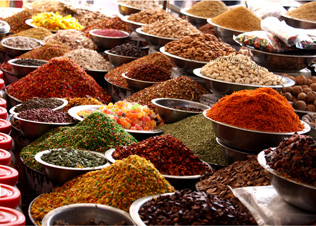News
A-Z of spices
Wednesday, August 8th, 2012
Spices are the stars of almost every country’s cuisine. They create a flavour signature that’s unmistakeable, such as the wafting warmth of glühwein, the fiery hit of garam masala, or the complex aroma of Chinese five spice. These fragrant roots, fruits, seeds and bark are the best way to – quite literally – spice up a dish.
Endless jars of amber and red ground powders, oddly shaped seeds, sleek pods and dried berries can be a little daunting, however. This list will help you learn where they’re from, what they taste like, and how you can incorporate them into your cooking.
Allspice
This dried berry, also known as Jamaican pepper, has a distinctive flavour which is reminiscent of nutmeg and cinnamon. It is used extensively in Caribbean and Middle Eastern cooking. Enjoy it in mutton biryani.
Asafoetida
This spice has a rather unappealing smell, which disappears when cooked and lends a fragrant onion or leek flavour. It adds depth to vegetarian Indian dishes and those of Afghanistan. Try it in this recipe for khadi kitchari.
Black pepper
The world’s most traded spice, black pepper begins its life as a green berry before being sun-dried to its characteristic black. (White pepper is from the same berry, with the darker skin removed by soaking.) Enjoy it in lemon and black pepper pasta with stracciatella cheese and artichokes.
Caraway seeds
With a similar flavour to aniseed, caraway is popular in breads, sausages and soups in German and Eastern European cooking.
Cardamom
Green cardamom is a staple of Indian cookery. Bruise the pods to release the small seeds – and their flavour – and use them in sweet and savoury dishes and teas. Try it in this pickled fish or spiced mandarins with vanilla honey yoghurt.
Cayenne pepper
This spice is made from ground red cayenne peppers and gives heat to dishes from soups to barbeque chicken wings and everything in between. Try it in this Cape Winelands lamb tagine.
Cinnamon
Arguably one of the most distinctive spices, cinnamon is very aromatic and fragrant. Sticks are used in stews and curries, while the powder is more often sprinkled onto sweets and baked goods. Enjoy it in pumpkin fritters or mutton biryani.
Cloves
The dried flower buds from tropical trees found in Southeast Asia, cloves are very strong and spicy. Their Christmassy aroma can be found in meat, sweet dishes and drinks like glühwein. Try it in gammon or lamb riblets with Moroccan spices.
Coriander seeds
These dried seeds are roasted and used to flavour biltong, or ground for dry spice mixes and curry powders. Try it in this carrot and coriander soup.
Cumin (also known as jeera)
A staple of Indian and North African food, cumin seeds can be fried and then crushed, or you could use the ready ground spice. Try it in bunny chow with sugar bean and vegetable curry or warm Mexican red bean birria.
Fennel seeds
Popular in Italian sausages and some rye breads, fennel seeds have a flavour similar to anise. They are also used in Chinese five spice and Sri Lankan curries. Try fennel seeds in these marinated olives.
Fenugreek seeds
These seeds are common in pickles, curry powders and pastes in Mediterranean, Indian and Moroccan cuisine.
Five spice powder
Used widely in Chinese cookery, this spice is a combination of cinnamon, cloves, szechuan pepper, fennel and star anise. It suits both sweet desserts and savoury dishes.
Galangal
Popular in Asian cooking for soups and stews, galangal pairs well with ginger. Try it an aromatic laksa lemak or this simple Thai butternut soup.
Garam masala
This proprietary blend of dry spices used in North Indian and South Asian cookery combines some of the following spices: cumin, nutmeg, bay leaves, coriander, peppercorns, star anise, mace, cinnamon and cloves. Spice up your roasted potatoes by tossing them in some garam masala before roasting.
Ginger
From the same plant family as turmeric, galangal and cardamom, ground ginger is often used in conjunction with garlic and onions to make a warm and pungent base for chicken and meat curry dishes. It is also used in drinks like ginger beer and tea. Try it in chicken bunny chow with tomato and yoghurt.
Mustard seed
Black, brown and white mustard seeds are used in many Indian recipes. Cooking them in hot oil releases their flavour for dhals and other vegetable dishes. Try it in bunny chow with sugar bean and vegetable curry.
Nutmeg
Ground nutmegs is popular in classic macaroni cheese, creamy mashed potatoes and other savoury egg- and milk-based dishes. It also adds flavour to cakes and biscuits. Use it in this summery spaghetti bolognaise or sweet potato gnocchi with shredded lamb.
Paprika
Made from ground mild peppers, paprika is used extensively in Hungarian and Spanish cooking. It gives dishes a rich red colour and can add heat to stews like goulash, rice dishes like paella, and other meat recipes. Try it in chicken with smoked paprika, bacon and white beans, braaied pork fillet with braised tomato and chickpea salad, or tapenade soda bread.
Poppy seeds
These little purple-grey seeds are used as a decorative garnish in breads but also as a spice and thickening agent in Indian curries. Try them in avocado, cucumber and fennel bulb salad with poppy seed dressing (recipe courtesy of Woolworths TASTE).
Saffron
Regarded as the world’s most expensive spice, saffron is handpicked from the stamens of the saffron crocus. Infuse the strands in a little warm water before adding to dishes for its intense colour and hay-like and slightly sweet flavour. Try it in saffrom crème caramel with star anise or mutton biryani.
Sesame seeds
Seeds of the flowering sesame plant range from creamy white to black and are used for their nutty flavour. Enjoy them in orange-poached beetroot with goat’s cheese and spinach or sushi hand rolls.
Star anise
Star anise has a recognisable shape and characteristic flavour. It is used in biryani recipes, Chinese five spice and Indian spice mixtures like garam masala. Enjoy star anise in spiced mandarins with vanilla honey yoghurt.
Turmeric
This earthy, warm spice is ground from the root of the turmeric plant. The brilliant orange-yellow is distinct in curry powders. Try it in this pickled fish recipe or Cape Winelands lamb tagine.
Vanilla
These pods are cut open and their tiny wet seeds scraped out for use in predominately sweet and creamy dishes. Try this vanilla yoghurt panna cotta or vanilla and white wine-poached pears.








